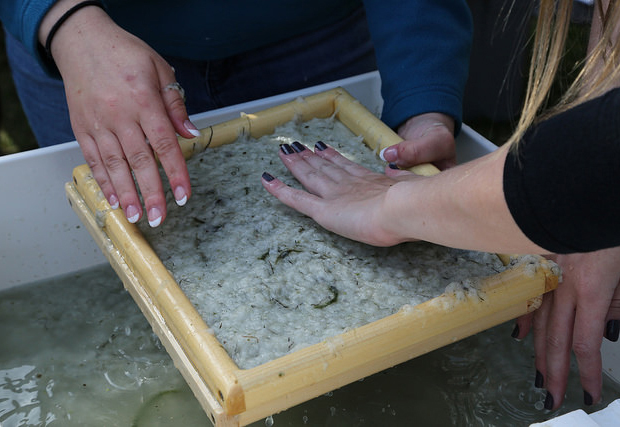 This is exactly how Alisha Curreri envisioned a liberal arts education. The senior psychology major is outdoors on a delightful autumn afternoon, her arms elbow-deep in a white utility sink slippery with an algae-cotton slurry. She’s one of almost a dozen art students who, side-by-side with an equal amount of ecology students, is creating paper from
This is exactly how Alisha Curreri envisioned a liberal arts education. The senior psychology major is outdoors on a delightful autumn afternoon, her arms elbow-deep in a white utility sink slippery with an algae-cotton slurry. She’s one of almost a dozen art students who, side-by-side with an equal amount of ecology students, is creating paper from  plant matter pulled from Elizabethtown College’s Lake Placida.
plant matter pulled from Elizabethtown College’s Lake Placida.
“I like how two completely different majors came together for a common interest,” she said, taking a break from creating thick sheets of gelatinous and heavily speckled paper.
Last year at this time, David Bowne, E-town associate professor of biology, was contemplating a beneficial and environmentally responsible venture using the lake’s growth of algae and duckweed. “I was literally standing there in waders,” he said of the lightbulb moment.
I like how two completely different majors came together for a common interest.”
The plants, though visually disconcerting in their abundance, are not necessarily bad for the waterway, Bowne said. They provide homes for insects and invertebrates, which, in turn, are an aquatic food source. In addition, they store carbon dioxide, presently existing in alarming amounts thanks to excessive use of fossil fuels. “You can’t get rid of it …,” Bowne said of the gas. “It’s just a matter of where it’s stored.”
So, the papermaking project was created to teach collaboration while constructively storing a small amount of CO2.
 Bowne and Kristi Arnold, assistant professor of art, attended a papermaking workshop to learn about tools and techniques. Then, back on campus, the professors set about creating the perfect Placida paper brew. According to Arnold, their final mixture contains 10 percent algae or duckweed—the smallest flowering plant on the earth. The remaining 90 percent is cotton or abaca, also known as Manila hemp.
Bowne and Kristi Arnold, assistant professor of art, attended a papermaking workshop to learn about tools and techniques. Then, back on campus, the professors set about creating the perfect Placida paper brew. According to Arnold, their final mixture contains 10 percent algae or duckweed—the smallest flowering plant on the earth. The remaining 90 percent is cotton or abaca, also known as Manila hemp.
On papermaking day, the ecology students arrived first, mixing the fiber recipe to create just the right consistency. They dragged framed screens, known as moulds and deckles, through the viscous mixture and, as the frames drained, the algae fibers remained. The spongy concoction was flipped onto a piece of felt, and a pile of these creations was squeezed with a plant press pushing out additional water.
 The final product? Thick, speckled construction paper. “Think of it as an artful form of nori (pressed seaweed used to wrap sushi) mixed with abaca and cotton fibers,” said Arnold.
The final product? Thick, speckled construction paper. “Think of it as an artful form of nori (pressed seaweed used to wrap sushi) mixed with abaca and cotton fibers,” said Arnold.
The art students arrived later, giving the ecology students the opportunity to turn the tables and become the teachers. The art students will guide the ecology students in November, when both classes construct a final art installation. The artwork will be on display in the Lyet Gallery during finals week.
Marquise Henry was part of the ecology class that co-taught the art students. Though he was surprised by the class structure at first, he said he appreciated the teamwork involved in creating the paper and really liked the unique approach. “I thought we’d be sitting at desks writing a research paper, not MAKING paper.”



